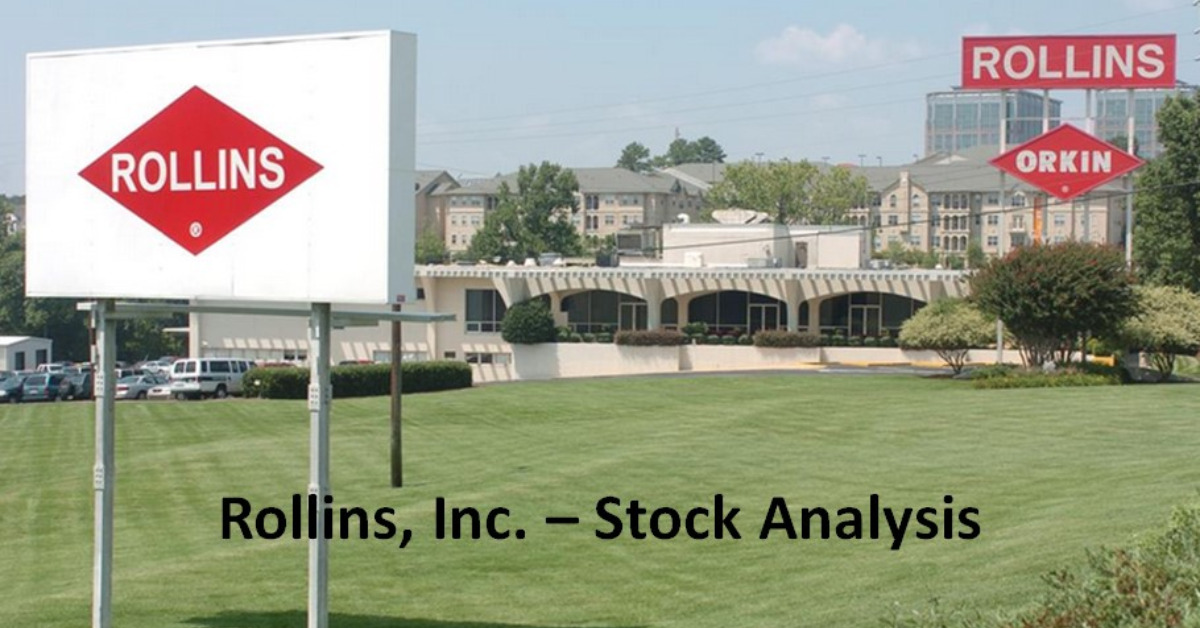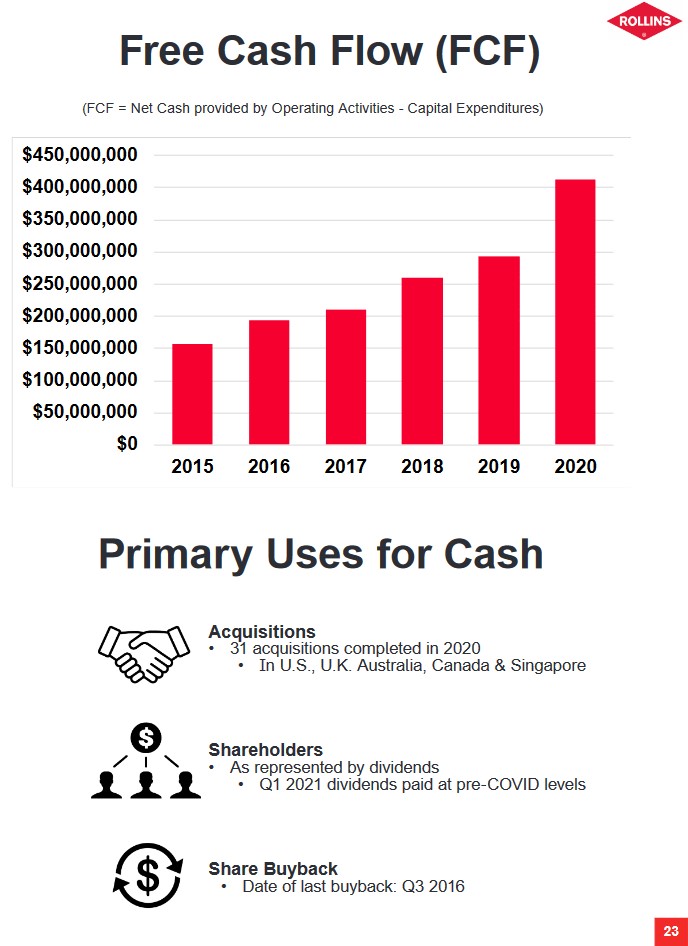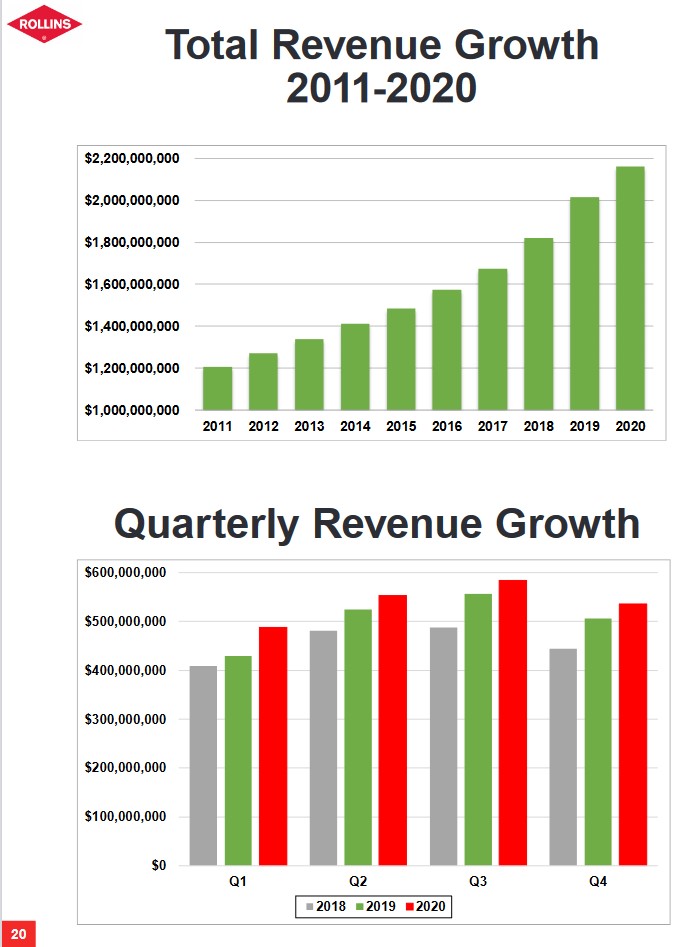Contents

On June 10, 2021, I initiated a 500 Rollins (ROL) shares position @ ~$33.15/share and explained my rationale for doing so in this Rollins stock analysis.
I subsequently reviewed ROL’s Q2 and YTD2021 results in my August 7th post. I now revisit ROL following the October 27th release of Q3 and YTD2021 results.
Rollins – Stock Analysis – Business Overview
Please refer to my June 10, 2021 post in which I present business and industry overviews.
A very high-level overview of ROL is accessible here. Section 1 of the FY2020 10-K also contains additional information.
US Securities and Exchange Commission (SEC) Investigation
On October 28, 2020, ROL filed its Q3 2020 10-Q with the SEC, disclosing an SEC investigation into how ROL established accruals and reserves at period-end and the impact of those accruals and reserves on reported earnings for periods beginning January 1, 2015.
ROL’s FY2020 Form 10-K later disclosed the results of an internal company-initiated investigation that found a significant deficiency in its internal controls relating to the documentation and review of accounting entries for certain reserves and accruals.
On October 29, 2021, ROL reported that it had initiated discussions with the SEC staff regarding a potential investigation resolution.
On the Q3 2021 quarterly conference call with analysts, management indicates it is unable to provide additional details other than Note 6 CONTINGENCIES on page 10 of 33 in the Q3 2021 Form 10-Q because of the ongoing investigation.
In accordance with accounting standard ASC 450, however, ROL has established a reserve related to this matter and has stated:
‘Management does not believe that any pending claim, proceeding or litigation, regulatory action or investigation, either alone or in the aggregate, will have a material adverse effect on the Company’s financial position, results of operations or liquidity; however, it is possible that an unfavourable outcome of some or all of the matters could result in a charge that might be material to the results of an individual quarter or year.’
ASC 450 as it relates to ‘Loss Contingency’ states:
‘An existing condition, situation, or set of circumstances involving uncertainty as to possible loss to an entity that will ultimately be resolved when one or more future events occur or fail to occur. The term loss is used for convenience to include many charges against income that are commonly referred to as expenses and others that are commonly referred to as losses.’
The specific amount in reserve is not disclosed; it is buried within ‘Other Current Liabilities’ of $60.833 million as of September 30, 2021. By way of comparison, ‘Other Current Liabilities’ on September 30, 2020 and September 30, 2019 are $64.868 million and $60.065 million. These two values are not materially different from the most recent ‘Other Current Liabilities’ value.
Acquisitions
ROL’s growth has been organic and through multiple acquisitions. In FY1996, ROL reported Annual Revenue of ~$0.533B. YTD2021 Annual Revenue is ~$1.824B and will likely be just shy of $2.5B at the end of FY2021.
The following image from ROL’s investor presentation provides additional information about its revenue growth.
Over the last 3 years, ROL has averaged 30 acquisitions per year (31 in FY2020). On the Q2 2021 Earnings call, management indicated it had closed 18 deals YTD. The YTD closed deals at the end of Q3 is 26.
Rollins – Stock Analysis – Financials
Q3 and YTD 2021 Results
I reference ROL’s Q3 and YTD results found in the Q3 2021 8-K and Q3 2021 10-Q.
Q3 2021’s gross margin increased to 53% or 0.4% over Q3 2020. ROL witnessed a strong improvement in materials and supplies. This was negatively offset by high overall fleet costs primarily from a ~$4 million increase in fuel costs over Q3 2020 and ~$900,000 less in the sale of vehicles compared to Q3 2020.
Sales, general and administrative expenses were strongly impacted by PPE donations and the SEC-related accrual.
Travel expenses have also increased by $1.3 million in Q3 as ROL has begun to lift company travel restrictions.
Amortization expenses for Q3 2021 increased ~$1.4 million due to the amortization of customer contracts from multiple acquisitions. This was offset by a decrease in depreciation of ~$201,000 due to the sale of owned vehicles and the centralization of IT function. Overall, this equated to a 5.1% increase in depreciation and amortization over Q3 2020.
YTD dividends of $119.7 million represent a ~30.4% increase over YTD2020.
ROL ended Q3 with ~$117.7 million in cash, of which ~$73.6 million is held by foreign subsidiaries. These funds are typically not repatriated to the US but are retained in other countries to fund ROL’s international operations and expansion.
Deferred Revenue
In previous posts, I have discussed the benefits of deferred revenue. If managed prudently, deferred revenue can be used to aid in a company’s growth.
In ROL’s case, it has ~$152 million of its customers’ money before it must contractually provide services. This amount is reflected as a current liability because ROL will provide services within the coming 12 months. Once the services are provided, the liability is reduced and ROL can reflect the money it previously collected as earned income.
Investors need to account for this when looking at ROL’s current ratio (current assets/current liabilities) and quick ratio (current assets minus materials and supplies/current liabilities).
If we do not account for ~$152 million of unearned revenue, it looks like ROL’s current ratio and quick ratio as of September 30, 2021 is .78:1 and .726:1.
Since ROL does not have to disburse ~$152 million within a year but merely has to render services for which it has already been paid in advance, I deduct the ~$152 million to arrive at ROL’s current total liabilities of ~$326 million. When I do this, the current ratio and quick ratio as of September 30, 2021 become 1.15:1 and 1.06. In doing this, we see that ROL does not have a liquidity issue.
Inclusion of Additional Metrics
In the Valuation section of my August 7th post I explain that due to the consistently high volume of acquisitions and hence high amortization expense related to these acquisitions, it is not practical to value ROL based on Earnings per Share (EPS). This is because Depreciation and Amortization are such a significant component of the ‘Adjustments to reconcile net income to net cash provided by operating activities’ in the Condensed Consolidated Statement of Cash Flows.
Management is clearly of the same opinion. On the Q3 earnings call with analysts, management stated it will now be presenting:
- Earnings before interest, taxes, depreciation and amortization (EBITDA)
- Free Cash Flow
The rationale for presenting these additional metrics is to more properly illustrate ROL’s strong ability to generate cash.
ROL will be using the simple approach to define free cash flow, which is net cash provided by operating activities less purchase of equipment and property.
Adjusted EBITDA
The Q3 2021 8-K includes Q3 and YTD adjusted EBITDA for comparison purposes due to the one-time super vesting of the late Chairman stock grants in Q3 2020 and the impact of the gain on the sale of several core properties in the first six months of 2021.
Q3 2021 EBITDA was $150.9 million or 8.7% over Q3 2020 adjusted EBITDA of $138.9 million.
YTD adjusted EBITDA was $422 million or 22.1% over YTD2020’s adjusted EBITDA of $344.9 million.
Free Cash Flow (FCF)
ROL has historically generated strong FCF. In FY2011 – FY2020, it generated (in millions of $) 136, 123, 144, 165, 157, 193, 211, 272, 292, and 413.

Source: ROL – Q4 2020 Investor Presentation – April 2, 2021
YTD it has generated ~$279 versus $323 during the first 3 quarters in FY2020; the is a 13.6% decrease from the first 3 quarters of FY2020.
In Q3 2021, FCF of $72.9 million was 27.5% lower than in Q3 2020. This negative fluctuation is attributed to the deferral of $30.3 million in FICA taxes payable in 2020 as allowed under the CARES Act. These associated taxes were remitted in September 2021.
NOTE: The Federal Insurance Contributions Act (FICA) is a U.S payroll tax deducted to fund the Social Security and Medicare programs.
The Coronavirus, Aid, Relief and Economic Security Act (CARES Act) allows employers to defer the deposit and payment of the employer’s share of Social Security taxes and self-employed individuals to defer payment of certain self-employment taxes.
ROL’s strong YTD FCF has enabled it to repay $135.5 million under its revolving commitment and ~$119.7 million of dividends.
FY2021 Guidance
Management does not provide guidance.
I place no reliance on adjusted diluted EPS estimates from the 3 – 4 brokers that cover ROL.
Rollins – Stock Analysis – Credit Ratings
ROL’s debt is not rated by any rating agency.
Details of ROL’s debt facilities are provided in Note 11 on page 14 of 33 in the Q3 10-Q.
ROL complies with applicable debt covenants and expects to maintain compliance throughout 2021.
Dividend and Dividend Yield
As noted in my previous posts, ROL’s dividend policy includes the distribution of a ‘special dividend’.
In early 2020, ROL’s Senior Vice President and CFO announced a reduction in the quarterly dividend, from $0.12 to $0.08 starting with its April 2020 dividend, as a precautionary measure:
‘We believe that there is a need for caution as we execute our plans in response to the impact of COVID-19. This is a proactive move that is consistent with our Company’s conservative balance sheet approach. We plan to return to our past dividend performance as soon as practical.’
Despite the reduction in the quarterly dividend, however, ROL increased the amount distributed in 2020 relative to 2019 for shareholders who held shares for the entire calendar year!
Page 21 of 91 in the FY2020 10-K states:
- In FY2020, a total of $160.5 million was paid in cash dividends ($0.33/share) including a special dividend paid in December 2020 of $0.09/share
- In FY2019, a total of $153.8 million was paid in cash dividends ($0.31/share) including a special dividend paid in December 2019 of $0.03/share.
YTD2021, ROL has distributed $119,677 million in dividends with $39,945 million distributed in Q3.
With the release of Q3 2021 results, ROL announced that the Board approved a 25% dividend increase. The quarterly dividend is now $0.10 (up from $0.08) commencing with the December 10, 2021 dividend payable to stockholders of record at the close of business on November 10, 2021. In addition, the Board approved a special dividend of $0.08 to also be paid on December 10, 2021.
So, in 2021, ROL will have distributed 3 quarterly $0.08 dividends, 1 quarterly $0.10 dividend, and 1 $0.08 ‘special dividend’ for a total of $0.42.
Based on the current ~$35.65 share price, the dividend yield is just over 1%.
I expect the bulk of ROL’s future total investment return will be predominantly in the form of capital appreciation.
ROL has had stock splits over the years with the most recent being a 3 for 2 stock split that was announced October 27, 2020.
When a company initiates a stock split, the number of outstanding shares increases and the price per share decreases. However, the value of the company does not change. As a result, stock splits help make shares more affordable to smaller investors. It also provides greater marketability and liquidity in the market.
ROL adopted a share repurchase plan in 2012 to repurchase up to 11.25 million shares of the Company’s common stock. Typically, shares repurchased are from employees for the payment of taxes on vesting restricted shares.
ROL did not purchase shares on the open market during the years ended December 31, 2020, 2019 and 2018. The number of shares outstanding for the past ~7 years has been relatively stagnant at ~491 – ~492 million shares.
Looking at the Consolidated Statement of Cash Flows for the 9 Months Ending September 30, 2021 (page 6 of 33) in the Q3 10-Q we see that the ‘Stock-based compensation expense’ of ~$11.8 million is not much different from the $10.6 million of ‘Cash paid for common stock purchased’.
Rollins – Stock Analysis – Valuation
ROL has elected to provide EBITDA and FCF going forward. I, however, prefer to use Operating Cash Flow (OCF) and FCF to gauge its valuation.
At the end of Q2 2021, ROL had generated ~$219.2 million and ~$206 million in OCF and FCF.
At the end of Q3 2021, ROL had generated ~$299 million and ~$279 million in OCF and FCF.
ROL’s business is somewhat stable and I expect FY2021 OCF and FCF will be ~$390 million and ~$360 million.
The weighted average number of shares outstanding is ~492 million and I expect this to remain relatively stable over the remainder of the current fiscal year.
Using my projections, I get:
- OCF/share of ~$0.80 (390/492) and the current ~$35.65 share price for a ~44.6 valuation based on OCF. At the time of my August post, the valuation was ~45 based on a $38.30 share price and ~46.5 at the time of my June 10, 2021 post (share price of ~$33.14).
- FCF/share of ~$0.73 (360/492) and the current ~$35.65 share price for a ~49 valuation based on FCF. At the end of Q2, I projected FY2021 FCF of ~$380 million giving me ~$0.77 FCF/share and a valuation of ~50 using a $38.30 share price.
In deriving these valuations I had to make various assumptions. Even if my OCF and FCF assumptions are off a bit, I think ROL would still be a bit rich.
Rollins – Stock Analysis – Final Thoughts
The strikes against ROL are:
- rising fuel prices;
- an SEC investigation for which the outcome is unknown; and
- ROL’s steep valuation.
However, I think these headwinds are insufficient to derail ROL’spotential to generate an attractive long-term total investment return.
I think ROL’s upside potential far outweighs the above for the following reasons:
- This is a highly fragmented industry. Ecolab (ECL) ($66.2B market cap) and ROL ($17.5B) are the two leading industry participants. Rentokil ($11.6B) and Terminix ($4.8B) are the two next largest industry participants;
- While ROL is growing organically, it has a proven track record of being able to quickly integrate accretive acquisitions;
- 93% of ROL’s revenue is derived from the US but it has a presence in 71 countries (launchpad for growth);
- Our climate change is leading to the proliferation of pest problems. One source I used in analyzing the pest control industry estimated the industry to be valued at $20.6B in 2019 and projected growth to $30B by 2027; this is a ~5.2% compound annual growth rate from 2020 to 2027. ROL is more conservative with its projections in that in its 2021 Investor Presentation it estimates the global industry to be ~$18B with an expected growth rate of 4 – 5% annually; and
- This is a labour-intensive industry and many smaller participants do not have the resources to implement a system such as ROL’s BOSS System (discussed in my June 10, 2021 post) to significantly reduce ‘technician downtime’.
My rationale for investing in ROL remains unchanged. I approach my ROL investment from the perspective that Gary W. Rollins, Chairman and CEO, clearly knows how to run a successful business. Were this not the case, Forbes would not estimate his net worth to be ~$5.2B as of November 18, 2021 and he would not rank #182 on the Forbes 400 2021 list.
By investing in ROL I hope to capitalize on Mr. Rollins proven ability to create wealth from the highly fragmented but strong growth potential pest control industry.
I wish you much success on your journey to financial freedom!
Note: Please send any feedback, corrections, or questions to finfreejourney@gmail.com.
Disclosure: I am long ROL and ECL.
Disclaimer: I do not know your circumstances and do not provide individualized advice or recommendations. I encourage you to make investment decisions by conducting your research and due diligence. Consult your financial advisor about your specific situation.
I wrote this article myself and it expresses my own opinions. I do not receive compensation for it and have no business relationship with any company mentioned in this article.



